Reversing Years for Global Food Security: A Review of the Food Security Situation in Sub-Saharan Africa (SSA)
Abstract
1. Introduction
- Why do SSA countries respond slowly to the SDG2 goal of “End hunger, achieve food security and improved nutrition, and promote sustainable agriculture”?
- What strategy should Sub-Saharan African countries adopt to improve food security sustainably?
1.1. An Overview of the Concept of Food Security
1.1.1. The Trend of the Global Food Insecurity Situation since 2000
1.1.2. Sub-Saharan Africa and the Global Hunger Index
2. The Sub-Saharan African Food Security Situation
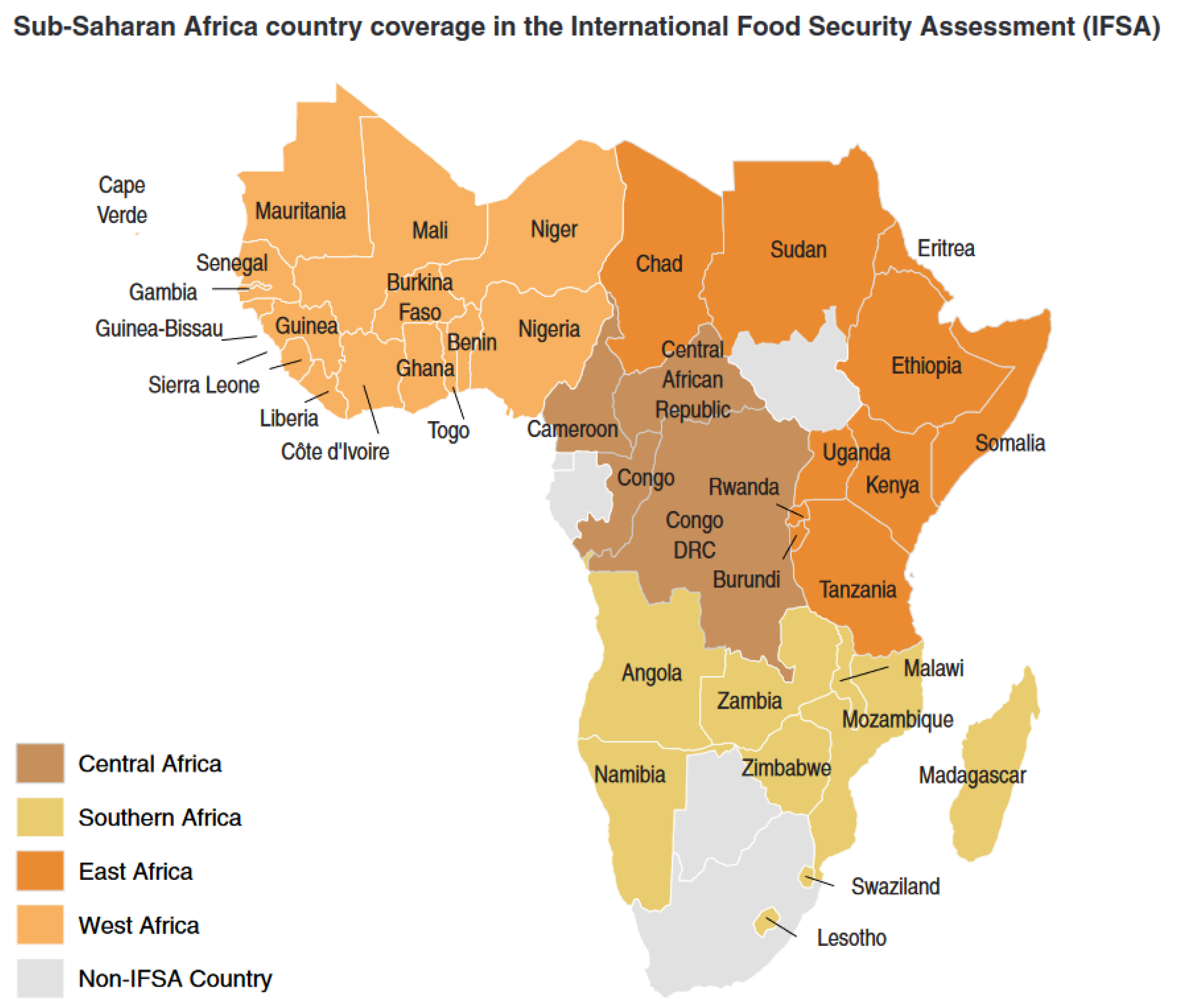
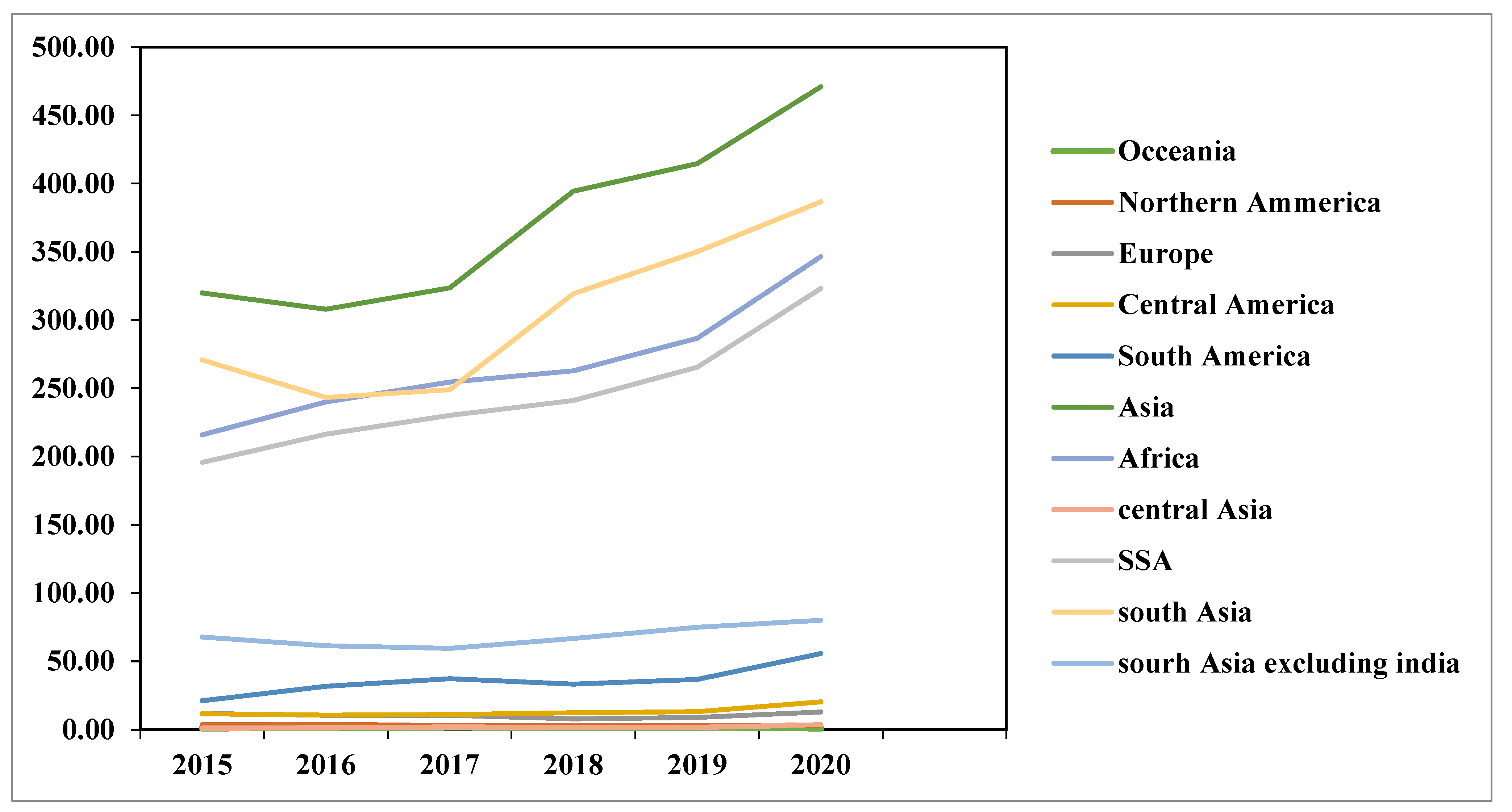
3. Why Is Sub-Saharan Africa the Worst in Terms of Food Insecurity?
3.1. Weak Economic Growth
3.2. Gender Inequality
3.3. Food Price Inflation
3.4. Low Crop Productivity
3.5. Drought
3.6. Low Investment in Irrigation Agriculture and Research
3.7. Climate Change
3.8. High Population Growth
3.9. Conflicts
3.10. Corruption
3.11. Other Factors
The Gateway to Sustainable Food Security in the SSA
4. Conclusions
Author Contributions
Funding
Institutional Review Board Statement
Informed Consent Statement
Data Availability Statement
Conflicts of Interest
References
- Xie, H.; Wen, Y.; Choi, Y.; Zhang, X. Global trends on food security research: A bibliometric analysis. Land 2021, 10, 119. [Google Scholar] [CrossRef]
- Cheteni, P.; Khamfula, Y.; Mah, G. Exploring food security and household dietary diversity in the Eastern Cape Province, South Africa. Sustainability 2020, 12, 1851. [Google Scholar] [CrossRef]
- Roman, J. Food security in sub-Saharan Africa. In Human Security and Development; Cornwell, L., Ed.; University of South Africa: Pretoria, South Africa, 2003. [Google Scholar]
- Vasileska, A.; Rechkoska, G. Global and regional food consumption patterns and trends. Procedia Soc. Behav. Sci. 2012, 44, 363–369. [Google Scholar] [CrossRef]
- Gentilini, U.; Webb, P. How are we doing on poverty and hunger reduction? A new measure of country performance. Food Policy 2008, 33, 521–532. [Google Scholar] [CrossRef]
- Erokhin, V.; Gao, T. Impacts of COVID-19 on trade and economic aspects of food security: Evidence from 45 developing countries. Int. J. Environ. Res. Public Health 2020, 17, 5775. [Google Scholar] [CrossRef]
- UNICEF. The State of Food Security and Nutrition in the World 2021; Food and Agriculture Organization of the United Nations: Rome, Italy, 2021.
- Fraval, S.; Hammond, J.; Bogard, J.R.; Ng’Endo, M.; van Etten, J.; Herrero, M.; Oosting, S.J.; de Boer, I.J.M.; Lannerstad, M.; Teufel, N.; et al. Food access deficiencies in sub-Saharan Africa: Prevalence and implications for agricultural interventions. Front. Sustain. Food Syst. 2019, 3, 104. [Google Scholar] [CrossRef]
- Onwujekwe, E.C.; Ezemba, C.C. Food Security and Safety: Africans Perspectives A Review. Arch. Curr. Res. Int. 2021, 21, 14–20. [Google Scholar] [CrossRef]
- Songwe, V.; Awiti, C. African Countries’ Debt: A Tale of Acceleration at Multiple Speeds and Shades. J. Afr. Econ. 2021, 30, i14–i32. [Google Scholar] [CrossRef]
- Botreau, H.; Cohen, M.J. Gender inequality and food insecurity: A dozen years after the food price crisis, rural women still bear the brunt of poverty and hunger. Adv. Food Secur. Sustain. 2020, 5, 53–117. [Google Scholar]
- Ngcamu, B.; Chari, F. Drought influences on food insecurity in Africa: A Systematic literature review. Int. J. Environ. Res. Public Health 2020, 17, 5897. [Google Scholar] [CrossRef]
- Campbell, B.M.; Vermeulen, S.J.; Aggarwal, P.K.; Corner-Dolloff, C.; Girvetz, E.; Loboguerrero, A.M.; Ramirez-Villegas, J.; Rosenstock, T.; Sebastian, L.; Thornton, P.K.; et al. Reducing risks to food security from climate change. Glob. Food Secur. 2016, 11, 34–43. [Google Scholar] [CrossRef]
- Sirba, H.Y.; Chimdessa, T.B. Review of Impact of Climate Change on Food Security in Africa. Int. J. Res. Innov. Earth Sci. 2021, 8. [Google Scholar]
- Prosekov, A.Y.; Ivanova, S.A. Food security: The challenge of the present. Geoforum 2018, 91, 73–77. [Google Scholar] [CrossRef]
- Hossain, M.S.; Arshad, M.; Qian, L.; Zhao, M.; Mehmood, Y.; Kächele, H. Economic impact of climate change on crop farming in Bangladesh: An application of Ricardian method. Ecol. Econ. 2019, 164, 106354. [Google Scholar] [CrossRef]
- Zięba, Z.; Dąbrowska, J.; Marschalko, M.; Pinto, J.; Mrówczyńska, M.; Leśniak, A.; Kazak, J.K. Built environment challenges due to climate change. In IOP Conference Series: Earth and Environmental Science; IOP Publishing: Bristol, UK, 2020; Volume 609, p. 012061. [Google Scholar]
- Kershaw, T.; Eames, M.; Coley, D. Assessing the risk of climate change for buildings: A comparison between multi-year and probabilistic reference year simulations. Build. Environ. 2011, 46, 1303–1308. [Google Scholar] [CrossRef]
- Mills, E.J.; Adhvaryu, A.; Jakiela, P.; Birungi, J.; Okoboi, S.; Chimulwa, T.N.W.; Wanganisi, J.; Achilla, T.; Popoff, E.; Golchi, S.; et al. Unconditional cash transfers for clinical and economic outcomes among HIV-affected Ugandan households. AIDS 2018, 32, 2023–2031. [Google Scholar] [CrossRef] [PubMed]
- Ebeke, C.H.; Etoundi, S.M.N. The effects of natural resources on urbanization, concentration, and living standards in Africa. World Dev. 2017, 96, 408–417. [Google Scholar] [CrossRef]
- Cline-Cole, R. Paths Through Socio-Economic Change, Livelihoods and Development in West African Worlds West African Worlds; Routledge: Oxfordshire, UK, 2016; pp. 17–56. [Google Scholar]
- Rena, R. Drought vs. Food Security in Eritrea; The World and I Online Journal: New York, NY, USA, 2006. [Google Scholar]
- Mabrouk, F.; Mekni, M.M. Remittances and food security in African countries. Afr. Dev. Rev. 2018, 30, 252–263. [Google Scholar] [CrossRef]
- Ibukun, C.O.; Adebayo, A.A. Household food security and the COVID-19 pandemic in Nigeria. Afr. Dev. Rev. 2021, 33, S75–S87. [Google Scholar] [CrossRef]
- Applanaidu, S.D.; Abu Bakar, N.; Baharudin, A.H. An econometric analysis of food security and related macroeconomic variables in Malaysia: A vector autoregressive approach (VAR). UMK Procedia 2014, 1, 93–102. [Google Scholar] [CrossRef]
- Nsiah, C.; Fayissa, B. Trends in agricultural production efficiency and their implications for food security in sub-Saharan African countries. Afr. Dev. Rev. 2019, 31, 28–42. [Google Scholar] [CrossRef]
- Webb, T.L.; Sheeran, P. Does changing behavioral intentions engender behavior change? A meta-analysis of the experimental evidence. Psychol. Bull. 2006, 132, 249–268. [Google Scholar] [CrossRef] [PubMed]
- Izraelov, M.; Silber, J. An assessment of the global food security index. Food Secur. 2019, 11, 1135–1152. [Google Scholar] [CrossRef]
- Frank, S.; Havlík, P.; Soussana, J.-F.; Levesque, A.; Valin, H.; Wollenberg, E.; Herrero, M. Reducing greenhouse gas emissions in agriculture without compromising food security? Environ. Res. Lett. 2017, 12, 105004. [Google Scholar] [CrossRef]
- Roser, M.; Ritchie, H. Hunger and Undernourishment; Our World in Data: Oxfordshire, UK, 2019. [Google Scholar]
- Squires, V.R.; Gaur, M.K. (Eds.) Food Security and Land Use Change under Conditions of Climatic Variability: A Multidimensional Perspective; Springer Nature: London, UK, 2020. [Google Scholar]
- UNICEF. The State of Food Security and Nutrition in the World 2022; Food and Agriculture Organization of the United Nations: Rome, Italy, 2022.
- Clapp, J.; Moseley, W.G. This food crisis is different: COVID-19 and the fragility of the neoliberal food security order. J. Peasant Stud. 2020, 47, 1393–1417. [Google Scholar] [CrossRef]
- Devereux, S.; Maxwell, S. Food Security in Sub-Saharan Africa; ITDG Publishing: West Yorkshire, UK, 2001. [Google Scholar]
- GHI. Global Regional and National Trend 2022. Available online: https://www.globalhungerindex.org/trends.html (accessed on 1 November 2022).
- de Carvalho, C.A.; Viola, P.C.D.A.F.; Sperandio, N. How is Brazil facing the crisis of Food and Nutrition Security during the COVID-19 pandemic? Public Health Nutr. 2021, 24, 561–564. [Google Scholar] [CrossRef]
- Guttal, S. Re-imagining the UN Committee on World Food Security. Development 2021, 64, 227–235. [Google Scholar] [CrossRef]
- Farsund, A.A.; Daugbjerg, C.; Langhelle, O. Food security and trade: Reconciling discourses in the Food and Agriculture Organization and the World Trade Organization. Food Secur. 2015, 7, 383–391. [Google Scholar] [CrossRef]
- Utuk, I.O.; Daniel, E.E. Land degradation: A threat to food security: A global assessment. J. Environ. Earth Sci. 2015, 5, 13–21. [Google Scholar]
- Juma, F.K. Effects of Mining on Food Security to Farming Communities Surrounding Nyamongo Gold Mine in Tarime District, Tanzania. Ph.D. Thesis, Sokoine University of Agriculture, Morogoro, Tanzania, 2015. [Google Scholar]
- Baquedano, F.; Christensen, C.; Ajewole, K.; Beckman, J. International Food Security Assessment, 2020–30, GFA-31, U.S.; Department of Agriculture, Economic Research Service: Washington, DC, USA, 2020. [Google Scholar]
- Islam, F.; Alam, G.; Begum, R.; Sarker, M.N.I.; Bhandari, H. Vulnerability, Food Security and Adaptation to Climate Change of Coastal Rice Farmers in Bangladesh Climate Vulnerability and Resilience in the Global South; Springer: Midtown Manhattan, NY, USA, 2021; pp. 187–197. [Google Scholar]
- Aboaba, K.O.; Fadiji, D.M.; Hussayn, J.A. Determinants of food security among rural households in Southwestern Nigeria: USDA food security questionnaire core module approach. J. Agribus. Rural Dev 2020, 2, 113–124. [Google Scholar] [CrossRef]
- Herforth, A.; Bai, Y.; Venkat, A.; Mahrt, K.; Ebel, A.; Masters, W.A. Cost and affordability of healthy diets across and within countries: Background paper for The State of Food Security and Nutrition in the World 2020. In FAO Agricultural Development Economics Technical Study No. 9; Food and Agriculture Organization of the United Nations: Rome, Italy, 2020; Volume 9. [Google Scholar]
- Sachs, J.; Kroll, C.; Lafortune, G.; Fuller, G.; Woelm, F. Sustainable Development Report 2022; Cambridge University Press: Cambridge, UK, 2022. [Google Scholar]
- Yeboua, K.; Cilliers, J.; Le Roux, A. Nigeria in 2050: Major player in the global economy or poverty capital? ISS West Afr. Rep. 2022, 2022, 1–64. [Google Scholar]
- Devi, S. Climate change driving east Africa towards famine. Lancet 2022, 400, 150–151. [Google Scholar] [CrossRef]
- World Health Organization. The State of Food Security and Nutrition in the World 2019: Safeguarding Against Economic Slowdowns and Downturns; Food & Agriculture Org: Rome, Italy, 2019; Volume 2019. [Google Scholar]
- Gassara, G.; Chen, J. Household Food Insecurity, Dietary Diversity, and Stunting in Sub-Saharan Africa: A Systematic Review. Nutrients 2021, 13, 4401. [Google Scholar] [CrossRef] [PubMed]
- Wang, Q.; Dima, M.; Ho-Foster, A.; Molebatsi, K.; Modongo, C.; Zetola, N.M.; Shin, S.S. The association of household food insecurity and HIV infection with common mental disorders among newly diagnosed tuberculosis patients in Botswana. Public Health Nutr. 2020, 25, 913–921. [Google Scholar] [CrossRef]
- Wang, D.; Andrée, B.P.J.; Chamorro, A.F.; Spencer, P.G. Transitions into and out of food insecurity: A probabilistic approach with panel data evidence from 15 countries. World Dev. 2022, 159, 106035. [Google Scholar] [CrossRef]
- Popp, J.; Oláh, J.; Kiss, A.; Lakner, Z. Food security perspectives in sub-Saharan Africa. Amfiteatru. Econ. 2019, 21, 361–376. [Google Scholar] [CrossRef]
- Timmer, P. Food Security and Economic Growth: An Asian Perspective; Center for Global Development Working Paper: Washington, DC, USA, 2004; Volume 51. [Google Scholar]
- Harrigan, J. Food insecurity, poverty and the Malawian Starter Pack: Fresh start or false start? Food Policy 2008, 33, 237–249. [Google Scholar] [CrossRef]
- Chambo, S.A. Agricultural co-operatives: Role in food security and rural development. In Proceedings of the Group Meeting on Co-operatives, New York, NY, USA, 28–30 April 2009; Available online: https://www.un.org/esa/socdev/egms/docs/2009/cooperatives/Chambo.pdf (accessed on 8 November 2022).
- Adam, C.; Henstridge, M.; Lee, S. After the lockdown: Macroeconomic adjustment to the COVID-19 pandemic in sub-Saharan Africa. Oxf. Rev. Econ. Policy 2020, 36, S338–S358. [Google Scholar] [CrossRef]
- Clift, B.; Robles, T.-A. The IMF, tackling inequality, and post-neoliberal ‘reglobalization’: The paradoxes of political legitimation within economistic parameters. Globalizations 2021, 18, 39–54. [Google Scholar] [CrossRef]
- Harrigan, J.; Wang, C.; El-Said, H. The economic and political determinants of IMF and World Bank lending in the Middle East and North Africa. World Dev. 2006, 34, 247–270. [Google Scholar] [CrossRef]
- Women, U.N. Promoting Women’s Economic Empowerment: Recognizing and Investing in the Care Economy; Issue Paper; UN Women: New York, NY, USA, 2018. [Google Scholar]
- Agarwal, B. Gender equality, food security and the sustainable development goals. Curr. Opin. Environ. Sustain. 2018, 34, 26–32. [Google Scholar] [CrossRef]
- Allendorf, K. Do women’s land rights promote empowerment and child health in Nepal? World Dev. 2007, 35, 1975–1988. [Google Scholar] [CrossRef] [PubMed]
- Tayal, D. Gender inequality, reproductive rights and food insecurity in Sub-Saharan Africa–A panel data study. Int. J. Dev. Issues 2019, 18, 191–208. [Google Scholar] [CrossRef]
- Doss, C.; Kovarik, C.; Peterman, A.; Quisumbing, A.; Bold, M.V.D. Gender inequalities in ownership and control of land in Africa: Myth and reality. Agric. Econ. 2015, 46, 403–434. [Google Scholar] [CrossRef]
- Udegbunam, M. Besides Insecurity, Land Rights Hamper Nigerian Women’s Farming Efforts. 2021. Available online: https://www.premiumtimesng.com/agriculture/agric-special-reports-and-investigations/477320-besides-insecurity-land-rights-hamper-nigerian-womens-farming-efforts.html (accessed on 29 October 2022).
- Basu, K. Understanding inflation and controlling it. Econ. Political Wkly. 2021, 46, 50–64. [Google Scholar]
- Wossen, T.; Berger, T.; Haile, M.G.; Troost, C. Impacts of climate variability and food price volatility on household income and food security of farm households in East and West Africa. Agric. Syst. 2018, 163, 7–15. [Google Scholar] [CrossRef]
- Ivanic, M.; Martin, W.J. Short-and Long-Run Impacts of Food Price Changes on Poverty. In World Bank Policy Research Working Paper; The World Bank: Washington, DC, USA, 2014; p. 7011. [Google Scholar]
- Verpoorten, M.; Arora, A.; Stoop, N.; Swinnen, J. Self-reported food insecurity in Africa during the food price crisis. Food Policy 2013, 39, 51–63. [Google Scholar] [CrossRef]
- Matz, J.A.; Kalkuhl, M.; Abegaz, G.A. The short-term impact of price shocks on food security-Evidence from urban and rural Ethiopia. Food Secur. 2015, 7, 657–679. [Google Scholar] [CrossRef]
- Rudloff, B. Sustainable And Resilient Agricultural Value Chains: Addressing Multiple Vulnerabilities with A New Partnership Approach; German Institute of Development and Sustainability: Bonn, Germany, 2022. [Google Scholar]
- Olabiyi, O.M. The effect of bureaucratic corruption on household food insecurity: Evidence from Sub-Saharan Africa. Food Secur. 2021, 14, 437–450. [Google Scholar] [CrossRef]
- Sasson, A. Food security for Africa: An urgent global challenge. Agric. Food Secur. 2012, 1, 2. [Google Scholar] [CrossRef]
- Chauvin, N.D.; Mulangu, F.; Porto, G. Food Production and Consumption Trends in Sub-Saharan Africa: Prospects for the Transformation of the Agricultural Sector; UNDP Regional Bureau for Africa: New York, NY, USA, 2012; Volume 2, p. 74. [Google Scholar]
- Bjornlund, V.; Bjornlund, H.; Van Rooyen, A.F. Why agricultural production in sub-Saharan Africa remains low compared to the rest of the world–a historical perspective. Int. J. Water Resour. Dev. 2020, 36, S20–S53. [Google Scholar] [CrossRef]
- Jayne, T.; Fox, L.; Fuglie, K.; Adelaja, A. Agricultural Productivity Growth, Resilience, and Economic Transformation in Sub-Saharan Africa; Association of Public and Land-grant Universities (APLU): Washington, DC, USA, 2021. [Google Scholar]
- Brautigam, D. Will Africa Feed China? Oxford University Press: Oxford, UK, 2015. [Google Scholar]
- Wei, C. Agroecology, information and communications technology, and smallholders’ food security in Sub-Saharan Africa. J. Asian Afr. Stud. 2020, 55, 1194–1208. [Google Scholar] [CrossRef]
- Moseley, W.G.; Battersby, J. The vulnerability and resilience of African food systems, food security, and nutrition in the context of the COVID-19 pandemic. Afr. Stud. Rev. 2020, 63, 449–461. [Google Scholar] [CrossRef]
- Sers, C.F.; Mughal, M. From Maputo to Malabo: Public agricultural spending and food security in Africa. Appl. Econ. 2019, 51, 5045–5062. [Google Scholar] [CrossRef]
- Assoumana, B.T.; Ndiaye, M.; Van Der Puije, G.; Diourte, M.; Gaiser, T. Comparative assessment of local farmers’ perceptions of meteorological events and adaptations strategies: Two Case Studies in Niger Republic. J. Sustain. Dev. 2016, 9, 118. [Google Scholar] [CrossRef]
- Simatele, D.; Binns, T.; Simatele, M. Sustaining livelihoods under a changing climate: The case of urban agriculture in Lusaka, Zambia. J. Environ. Plan. Manag. 2012, 55, 1175–1191. [Google Scholar] [CrossRef]
- Mmatlou, K. How Droughts Will Affect SOUTH Africa’s Broader Economy. 2019. Available online: https://theconversation.com/how-droughts-will-affect-south-africas-broader-economy-111378 (accessed on 28 October 2022).
- Kebede, A.Z.; Melchinger, A.E.; Cairns, J.E.; Araus, J.L.; Makumbi, D.; Atlin, G.N. Relationship of line per se and testcross performance for grain yield of tropical maize in drought and well-watered trials. Crop Sci. 2013, 53, 1228–1236. [Google Scholar] [CrossRef]
- Mekuria, T. The effects of Flooding and Drought on Clean Water Accesibility in Ethiopia; Hydraulic Engineering Repository: Karlsruhe, Germany, 2022. [Google Scholar]
- de Fraiture, C.; Giordano, M. Small private irrigation: A thriving but overlooked sector. Agric. Water Manag. 2014, 131, 167–174. [Google Scholar] [CrossRef]
- Namara, R.E.; Hope, L.; Sarpong, E.O.; De Fraiture, C.; Owusu, D. Adoption patterns and constraints pertaining to small-scale water lifting technologies in Ghana. Agric. Water Manag. 2014, 131, 194–203. [Google Scholar] [CrossRef]
- Porter, J.R.; Xie, L.; Challinor, A.J.; Cochrane, K.; Howden, S.M.; Iqbal, M.M.; Travasso, M.I. Food Security and Food Production Systems; IPCC: Geneva, Switzerland, 2014. [Google Scholar]
- Wichelns, D. Do estimates of water productivity enhance understanding of farm-level water management? Water 2014, 6, 778–795. [Google Scholar] [CrossRef]
- World Bank. Research and Development Expenditure (% of GDP)—Sub-Saharan Africa by Countries from 1980–2021. 2022. Available online: https://data.worldbank.org/indicator/GB.XPD.RSDV.GD.ZS?locations=ZG (accessed on 26 August 2022).
- Pickson, R.B.; Boateng, E. Climate change: A friend or foe to food security in Africa? Environ. Dev. Sustain. 2021, 24, 4387–4412. [Google Scholar] [CrossRef] [PubMed]
- Wachira, K. University world news Africa edition: Countries spend less than 1% of GDP on research. In Proceedings of the IAU 2022, 16th General Conference, University College Dublin, Dubilin, Ireland, 25–28 October 2022; University World News Africa Edition. University World News: London, UK, 2022. Available online: https://www.universityworldnews.com/post.php?story=20210616151534847 (accessed on 26 August 2022).
- Serdeczny, O.; Adams, S.; Baarsch, F.; Coumou, D.; Robinson, A.; Hare, W.; Schaeffer, M.; Perrette, M.; Reinhardt, J. Climate change impacts in Sub-Saharan Africa: From physical changes to their social repercussions. Reg. Environ. Chang. 2017, 17, 1585–1600. [Google Scholar] [CrossRef]
- Connolly-Boutin, L.; Smit, B. Climate change, food security, and livelihoods in sub-Saharan Africa. Reg. Environ. Chang. 2015, 16, 385–399. [Google Scholar] [CrossRef]
- Owusu, V.; Ma, W.; Renwick, A.; Emuah, D. Does the use of climate information contribute to climate change adaptation? Evidence from Ghana. Clim. Dev. 2021, 13, 616–629. [Google Scholar] [CrossRef]
- Trading Economics. Food Inflation. 2022. Available online: https://tradingeconomics.com/country-list/food-inflation (accessed on 4 September 2022).
- United Nations, Department of Economic and Social Affairs, Population Division. World Population Prospects 2019: Highlights (ST/ ESA/SER.A/423); United Nations: New York, NY, USA, 2019. [Google Scholar]
- Grecequet, M.; DeWaard, J.; Hellmann, J.J.; Abel, G.J. Climate vulnerability and human migration in global perspective. Sustainability 2017, 9, 720. [Google Scholar] [CrossRef]
- Hall, C.; Dawson, T.P.; Macdiarmid, J.I.; Matthews, R.; Smith, P. The impact of population growth and climate change on food security in Africa: Looking ahead to 2050. Int. J. Agric. Sustain. 2017, 15, 124–135. [Google Scholar] [CrossRef]
- Molotoks, A.; Smith, P.; Dawson, T.P. Impacts of land use, population, and climate change on global food security. Food Energy Secur. 2020, 10, e261. [Google Scholar] [CrossRef]
- Marx, B.; Stoker, T.; Suri, T. The economics of slums in the developing world. J. Econ. Perspect. 2013, 27, 187–210. [Google Scholar] [CrossRef]
- Von Grebmer, K.; Bernstein, J.; Nabarro, D.; Prasai, N.; Amin, S.; Yohannes, Y.; Thompson, J. 2016 Global Hunger Index: Getting to Zero Hunger; International Food Policy Research Institute: Washington, DC, USA, 2016. [Google Scholar]
- Boliko, M.C. FAO and the situation of food security and nutrition in the world. J. Nutr. Sci. Vitaminol. 2019, 65, S4–S8. [Google Scholar] [CrossRef]
- Adong, A. Armed Conflicts and Forced Displacements: Incentives and Consequences on Consumption and Social Preferences; Center for Effective Global Action: The University of California, Berkeley, CA, USA, 2021. [Google Scholar]
- Jacob, P.K.; Lenshie, N.E.; Okonkwo, I.M.-M.; Ezeibe, C.; Onuoha, J. Ambazonian Separatist Movement in Cameroon and the Dialectics of Cameroonian Refugee Crisis in Nigeria. J. Immigr. Refug. Stud. 2022, 28, 200–216. [Google Scholar] [CrossRef]
- Fang, X.; Kothari, S.; McLoughlin, C.; Yenice, M. The Economic Consequences of Conflict in Sub-Saharan Africa; International Monetary Fund location: Washington, DC, USA, 2020. [Google Scholar]
- Bircan, C.; Brück, T.; Vothknecht, M. Violent Conflict and Inequality. Oxf. Dev. Stud. 2016, 45, 125–144. [Google Scholar]
- Agunyai, S.C.; Ojakorotu, V. COVID-19, Human Displacement, and Expanding Crises of Insecurity in Africa: The case of Almajiri Children in Nigeria. Int. J. Criminol. Sociol. 2021, 10, 1443–1454. [Google Scholar]
- Mishra, A.K.; Mary, S. Does Food Insecurity Cause Civil War in sub-Saharan Africa? In Proceedings of the 2019 Agricultural & Applied Economics Association Annual Meeting, Atlanta, GA, USA, 21–23 July 2019.
- Chukwudi, O.F.; Chukwuma, O.J. State Violence, Separatist Agitations, and Population Displacement in Cameroon: Factors Breeding Separatist Agitations in Cameroon. In Globalization and Its Impact on Violence Against Vulnerable Groups; IGI Global: Hershey, PA, USA, 2020; pp. 165–193. [Google Scholar]
- Njangang, H.; Asongu, S.; Mouchili, E. Does corruption starve? An African perspective. In An African Perspective (11 March 2022); European Xtramile Centre of African Studies African Government and Development Institute (AGDI): Yaoundé, Cameroon, 2022. [Google Scholar]
- Önder, H. The impact of corruption on food security from a macro perspective. Future Food: J. Food Agric. Soc. 2021, 9, 1. [Google Scholar]
- Mbate, M.M. The Role of the State in Promoting Regional Integration and Private Sector Development. In Private Sector Development in West Africa; Springer: Cham, Bavaria, Germany, 2014; pp. 187–198. [Google Scholar]
- Anser, M.K.; Osabohien, R.; Olonade, O.; Karakara, A.A.; Olalekan, I.B.; Ashraf, J.; Igbinoba, A. Impact of ICT adoption and governance interaction on food security in West Africa. Sustainability 2021, 13, 5570. [Google Scholar] [CrossRef]
- Riley, L.; Chilanga, E. ‘Things are not working now’: Poverty, food insecurity and perceptions of corruption in urban Malawi. J. Contemp. Afr. Stud. 2018, 36, 484–498. [Google Scholar] [CrossRef]
- Adebayo, P.F.; Ojo, E.O. Food security in Nigeria: An overview. Eur. J. Sustain. Dev. 2012, 1, 199. [Google Scholar] [CrossRef]
- Balasubramanya, S.; Lele, U. Policy Note: Expanding Irrigation in Sub-Saharan Africa. Water Econ. Policy 2022, 8, 2171003. [Google Scholar] [CrossRef]
- Dodo, M.K. Understanding Africa’s food security challenges. In Food Security in Africa; BoD—Books on Demand: Norderstedt, Germany, 2020. [Google Scholar]
- Hagos, S.; Hailemariam, D.; WoldeHanna, T.; Lindtjørn, B. Spatial heterogeneity and risk factors for stunting among children under age five in Ethiopia: A Bayesian geo-statistical model. PLoS ONE 2017, 12, e0170785. [Google Scholar] [CrossRef]
- Woodhouse, P.; Muller, M. Water governance—An historical perspective on current debates. World Dev. 2017, 92, 225–241. [Google Scholar] [CrossRef]
- Hanjra, M.A.; Noble, A.; Langan, S.; Lautze, J. Feeding the 10 Billion within the Sustainable Development Goals Framework. In Food Production and Nature Conservation: Conflicts and Solutions; Taylor & Francis Group: Oxfordshire, UK, 2017; pp. 15–40. [Google Scholar]
- Pawlak, K.; Kołodziejczak, M. The role of agriculture in ensuring food security in developing countries: Considerations in the context of the problem of sustainable food production. Sustainability 2020, 12, 5488. [Google Scholar] [CrossRef]
- Littlewood, D.; Ciambotti, G.; Holt, D.; Steinfield, L. Special Issue Editorial: Social Innovation and Entrepreneurship in Africa; Taylor & Francis: Oxfordshire, UK, 2022; pp. 1–12. [Google Scholar]
- Sulemana, I.; Kpienbaareh, D. An empirical examination of the relationship between income inequality and corruption in Africa. Econ. Anal. Policy 2018, 60, 27–42. [Google Scholar] [CrossRef]
- Gyimah-Brempong, K. Corruption, economic growth, and income inequality in Africa. Econ. Gov. 2002, 3, 183–209. [Google Scholar] [CrossRef]
- Roy, A.; Basu, S. Determinants of livelihood diversification under environmental change in coastal community of Bangladesh. Asia-Pac. J. Rural. Dev. 2020, 30, 7–26. [Google Scholar] [CrossRef]
- Usman, Z.; Landry, D. Economic Diversification in AFRICA: How and Why It Matters; Carnegie Endowment for International Peace: Washington, DC, USA, 2021. [Google Scholar]
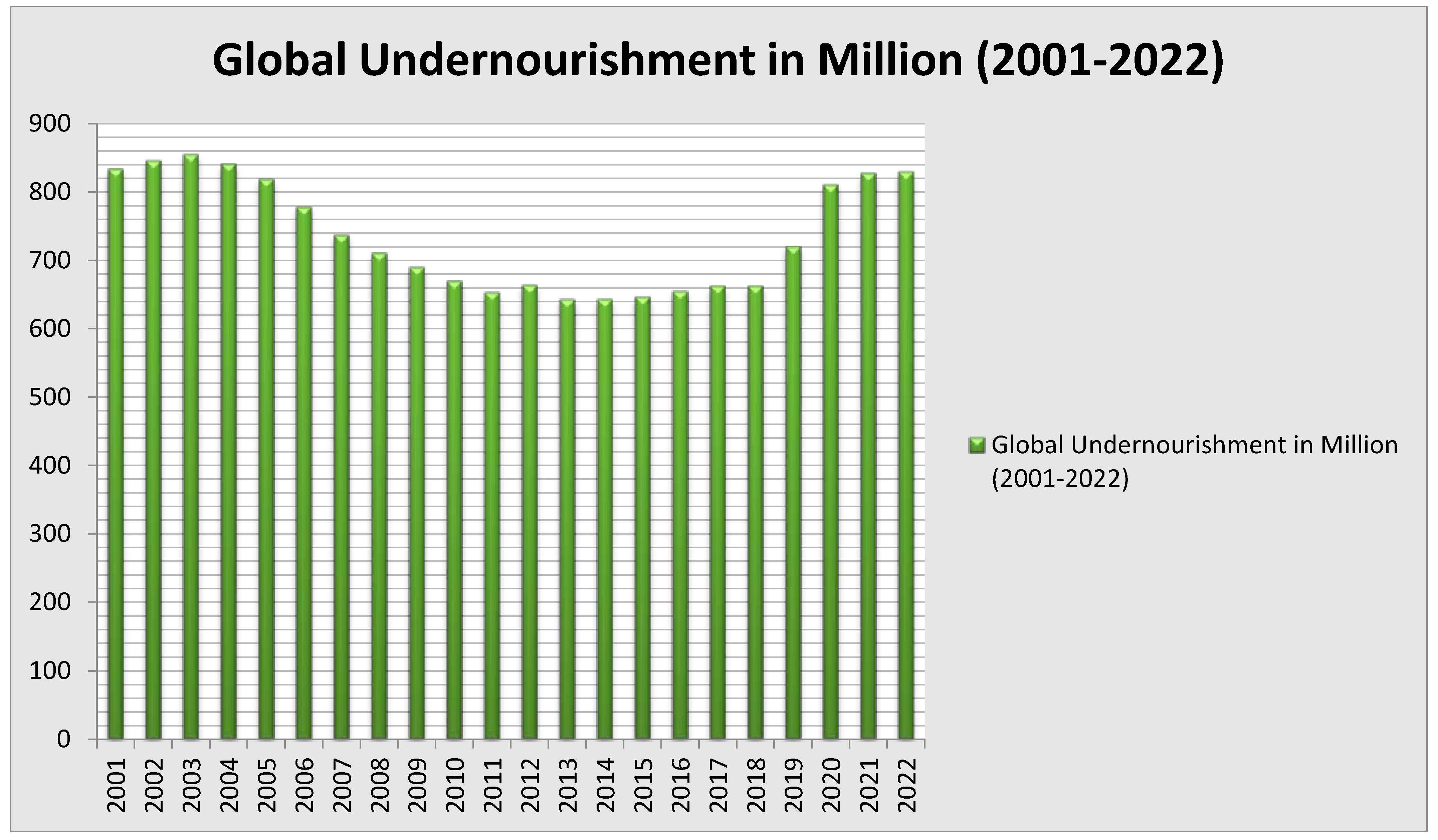
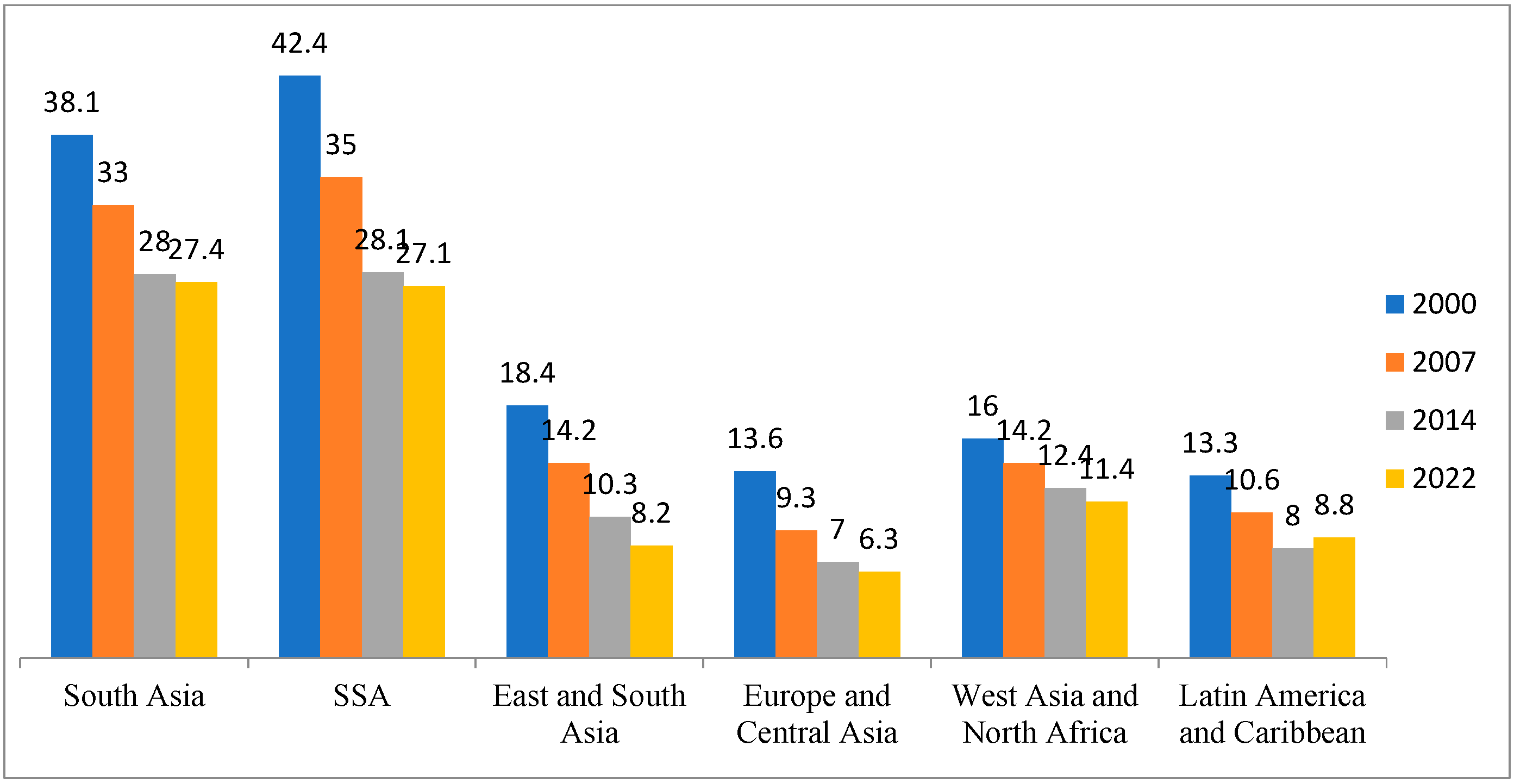

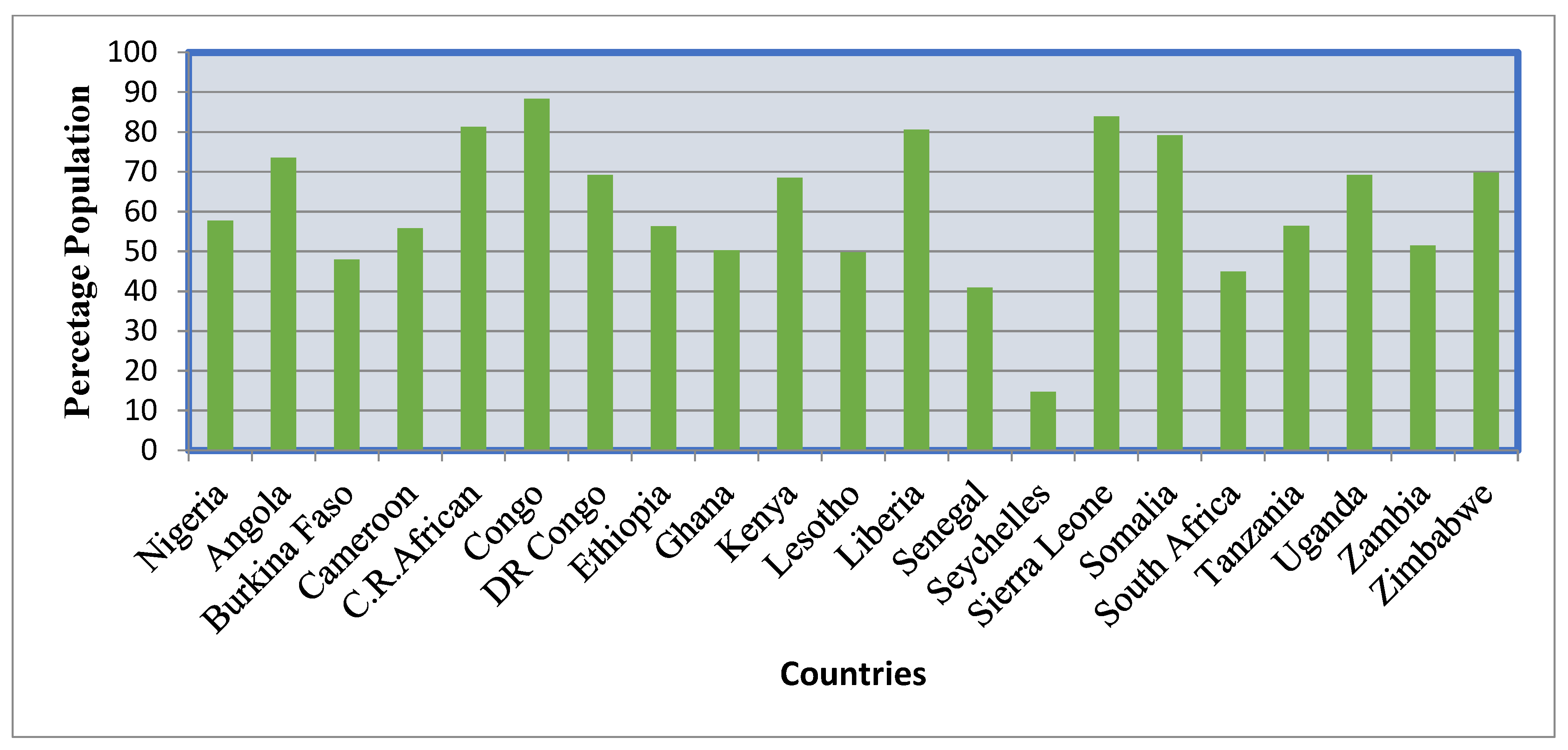

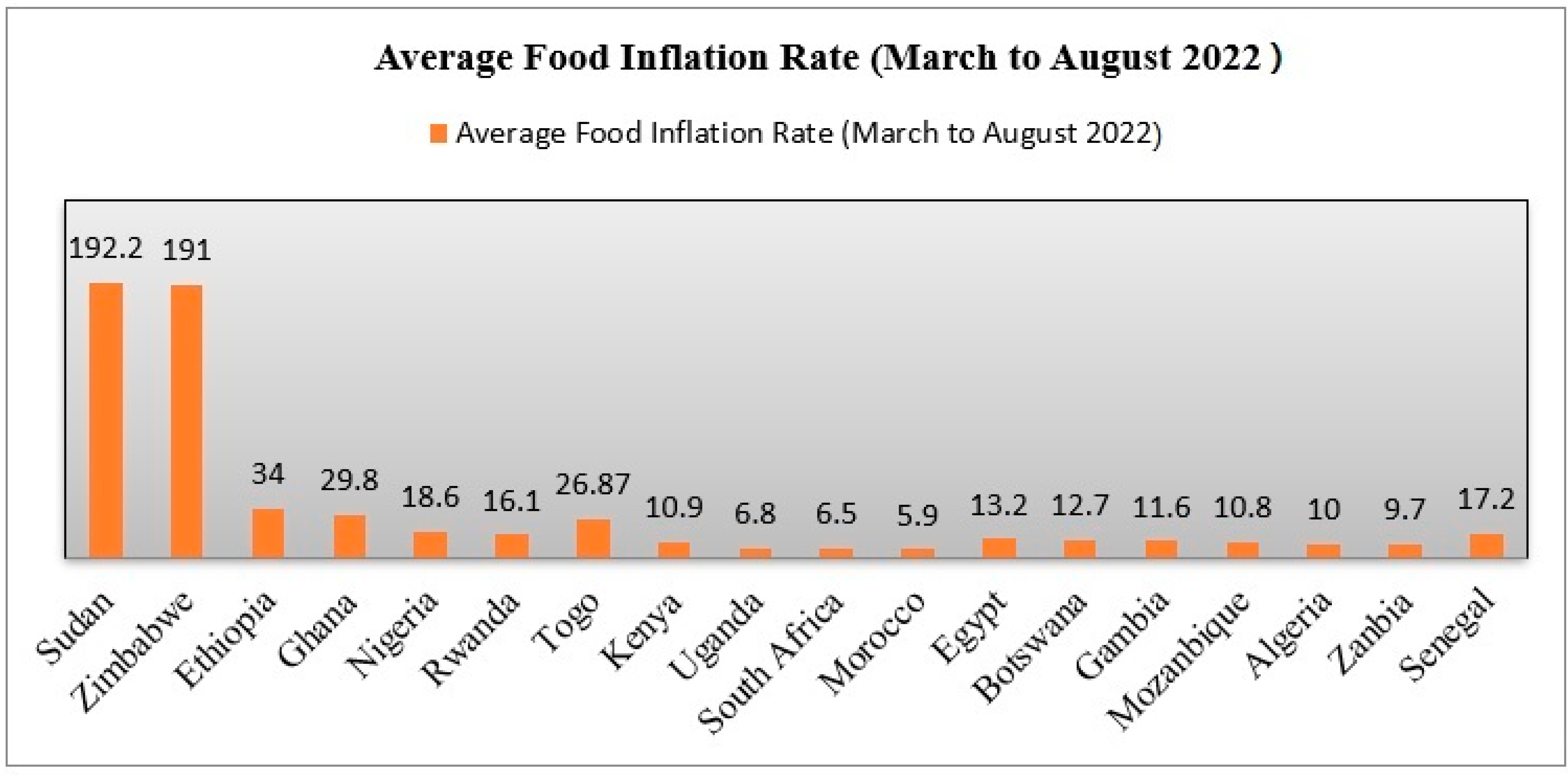
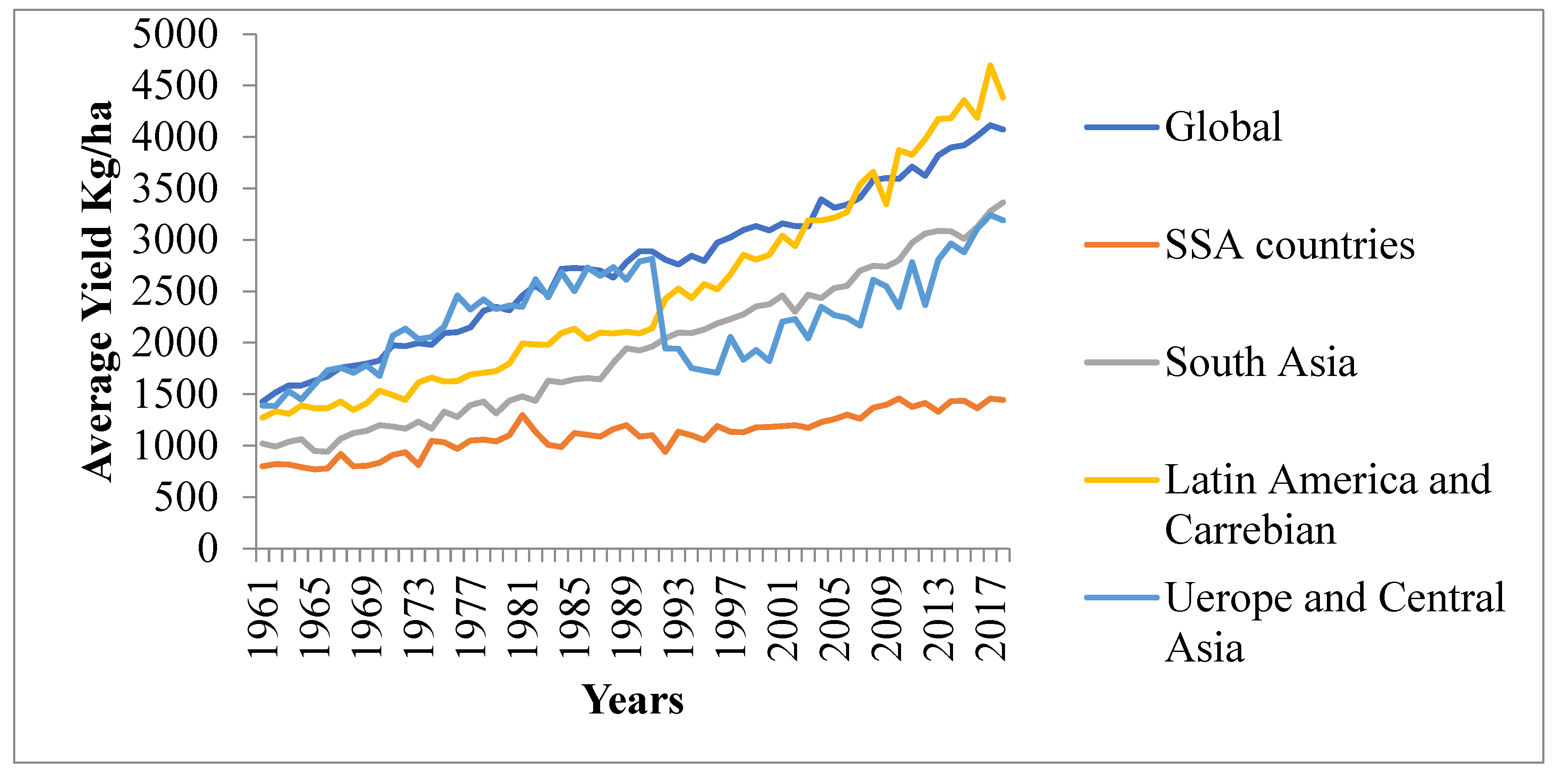
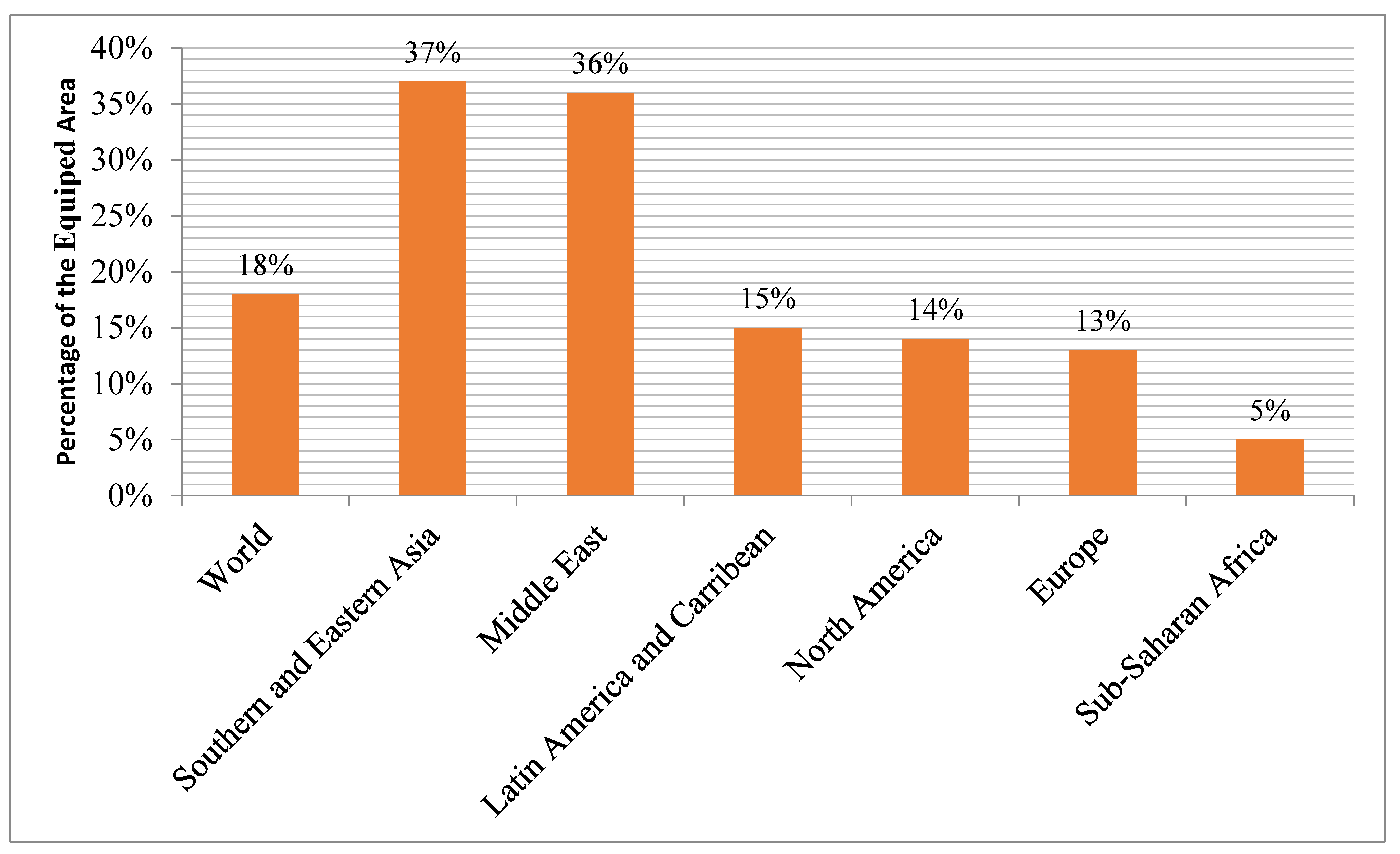
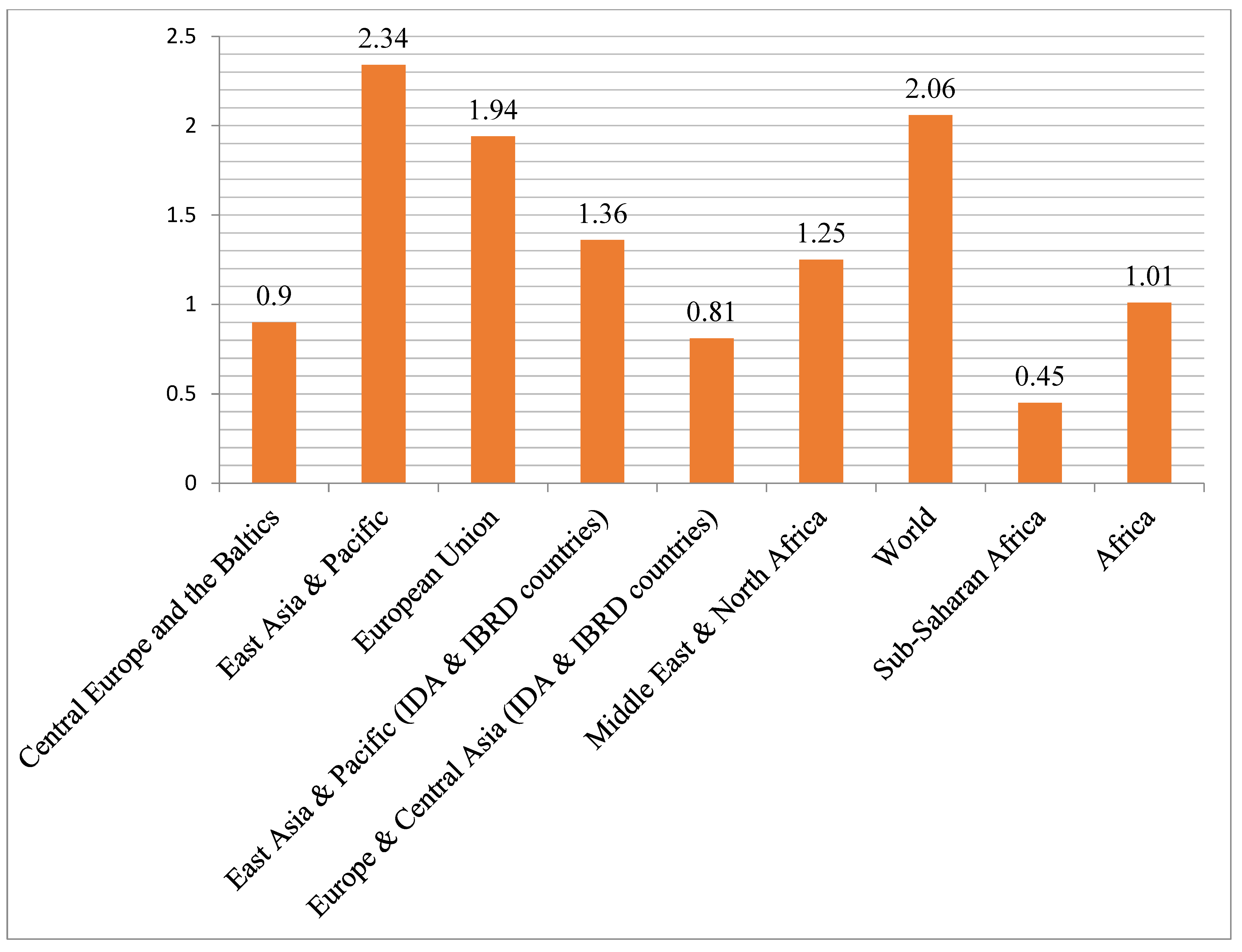

| S/N | Policy Option | References |
|---|---|---|
| 1. | Effective agricultural policies, provision of intermediate technology, women’s empowerment and social protection, farmers’ training, and adoption of a participatory approaches in agricultural projects and programs | [9,11] |
| 2. | Investments in irrigation and rural infrastructures for sustainable development and economic growth can improve food security at the regional or national level. | [116,118,119,120] |
| 3. | Transformation of the entire economy from a consumer-driven economy to a productive economy by enhancing productivity growth and regional trade. | [9,75] |
| 4. | Research and innovation in agriculture and entrepreneurship, as well as changing the direction of our education system toward skill acquisition | [121,122] |
| 5. | Measures to reduce income inequality, corruption, and poor governance | [123,124] |
| 6. | Improvement in macroeconomic policies, economic diversification, and structural reform, including privatization programs and social and human resource development. | [125,126] |
Publisher’s Note: MDPI stays neutral with regard to jurisdictional claims in published maps and institutional affiliations. |
© 2022 by the authors. Licensee MDPI, Basel, Switzerland. This article is an open access article distributed under the terms and conditions of the Creative Commons Attribution (CC BY) license (https://creativecommons.org/licenses/by/4.0/).
Share and Cite
Wudil, A.H.; Usman, M.; Rosak-Szyrocka, J.; Pilař, L.; Boye, M. Reversing Years for Global Food Security: A Review of the Food Security Situation in Sub-Saharan Africa (SSA). Int. J. Environ. Res. Public Health 2022, 19, 14836. https://doi.org/10.3390/ijerph192214836
Wudil AH, Usman M, Rosak-Szyrocka J, Pilař L, Boye M. Reversing Years for Global Food Security: A Review of the Food Security Situation in Sub-Saharan Africa (SSA). International Journal of Environmental Research and Public Health. 2022; 19(22):14836. https://doi.org/10.3390/ijerph192214836
Chicago/Turabian StyleWudil, Abdulazeez Hudu, Muhammad Usman, Joanna Rosak-Szyrocka, Ladislav Pilař, and Mortala Boye. 2022. "Reversing Years for Global Food Security: A Review of the Food Security Situation in Sub-Saharan Africa (SSA)" International Journal of Environmental Research and Public Health 19, no. 22: 14836. https://doi.org/10.3390/ijerph192214836
APA StyleWudil, A. H., Usman, M., Rosak-Szyrocka, J., Pilař, L., & Boye, M. (2022). Reversing Years for Global Food Security: A Review of the Food Security Situation in Sub-Saharan Africa (SSA). International Journal of Environmental Research and Public Health, 19(22), 14836. https://doi.org/10.3390/ijerph192214836









